The Birthplace of Chocolate
We love chocolate...that's a given. And while my preference is usually for either creamy luscious Belgian truffles or super-dark bitter bars, there's something special about visiting the magical cacao bean's original source.
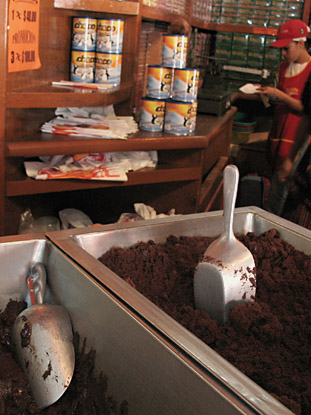 Mexican chocolate is a bit gritty and sweet, and often comes mixed with almonds and cinnamon. It's not that great for eating, but whenever we found ourselves with a chunk of chocolate and an underserved sweet tooth, we certainly took our nibbles. Mexican chocolate is versatile, put to good use in Oaxaca's famous moles and as a soothing drink.
Mexican chocolate is a bit gritty and sweet, and often comes mixed with almonds and cinnamon. It's not that great for eating, but whenever we found ourselves with a chunk of chocolate and an underserved sweet tooth, we certainly took our nibbles. Mexican chocolate is versatile, put to good use in Oaxaca's famous moles and as a soothing drink.
Chocolate Mayordomo is the most famous of the Oaxacan chocolate makers. With two free-standing shops downtown (considering how small Oaxaca is, this is on par with the Starbucks proliferation in New York), a stall in the 20 de Noviembre market and the bus station, it's hard to escape Mayordomo. The bigger shop seems more used to tourists, giving us samples of various chocolate pastes as soon as we entered; there's also a seating area in the back for enjoying chocolate in the store.
The choice is for hot chocolate made from a paste mixed with almond, sugar and cinnamon, or cold creamy chocolate milk (chocomil) made from their own brand of mix, Choco Mio. Hot chocolate can be made with water or milk. For the first day we all got it hot, and I opted to try it con agua out of curiosity. It's actually quite tasty, not as decadent as with milk but still very chocolate-y. It's a nice lighter option for drinking chocolate on a more regular basis.
While we sat at the bar, the counter girl whipped up a frothy batch of the Choco Mio and gave us samples...it was like having dessert. We knew we'd be getting the cold version next time. We watched the chocolate being ground and mixed with other ingredients, and left with heavy boxes of chocolate tablets. Next time I may try to buy the paste...it looked easier for melting.
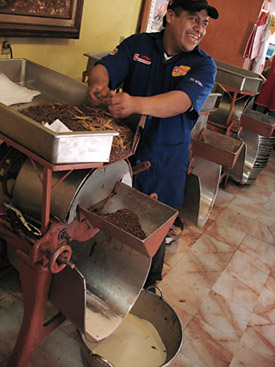 Combining chocolate with cinnamon and sugar | 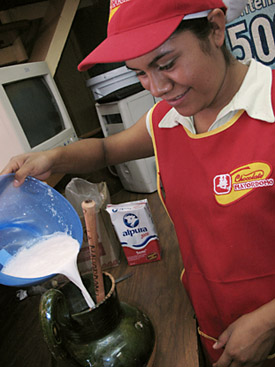 Mixing in hot milk |
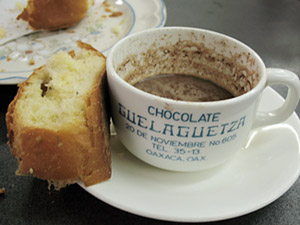 Mayordomo was a clear favorite, but we also gave Guelaguetza down the street a try. Not quite as brilliant, but still damn good! It wasn't nearly as popular and seemed to be family-run, while Mayordomo is a much larger operation. We tried a few pieces of the chocolate straight here, as well as a few steaming cups of chocolate con leche. At Guelaguetza we were offered pan dulce for dipping into the chocolate, so it was a great stop when we also needed a light snack. The kind proprietor made a little extra, so when we were about halfway finished she refilled our cups. On the way out we got delicious, foamy samples of their brand of chocomil.
Mayordomo was a clear favorite, but we also gave Guelaguetza down the street a try. Not quite as brilliant, but still damn good! It wasn't nearly as popular and seemed to be family-run, while Mayordomo is a much larger operation. We tried a few pieces of the chocolate straight here, as well as a few steaming cups of chocolate con leche. At Guelaguetza we were offered pan dulce for dipping into the chocolate, so it was a great stop when we also needed a light snack. The kind proprietor made a little extra, so when we were about halfway finished she refilled our cups. On the way out we got delicious, foamy samples of their brand of chocomil.
We ran into Pedro Martinez, our tour guide for Cuajimoloyas, during our final hour in Oaxaca City. He wanted to take us to dinner, but after a long afternoon at El Baresito, we were stuffed. He took us for more chocolate instead.
We stopped at a VERY popular street stall, a little further out of the center. While we hadn't noticed this corner before, there was a whole crowd of locals that obviously loved their tacos and tlayudas. Pedro ordered either champurrado or chocolate atole—not totally sure what they were calling it at this stand, but either way, it was chocolate mixed with ground corn. Rubina loved it, but Jasmine and I were less sure. It reminded me of when I was younger and my grandmother would try convincing me to eat my oatmeal by spooning some cocoa into it. It never really improved the situation. The flavor was hearty but the texture wasn't that pleasant. Much later, on the twisting road to the coast, both Jasmine and I were fighting to keep from getting sick and blamed it on that damn "chocolate corn."
Chocolate is served everywhere throughout the state, in markets, in fancy restaurants, even in the tiny comedor we visited in Cuajimoloyas. It's definitely one of the highlights of Oaxacan cuisine.
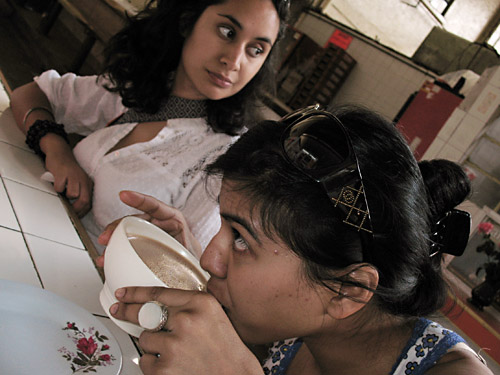
Rubina slurps some chocolate con leche for breakfast at the mercado